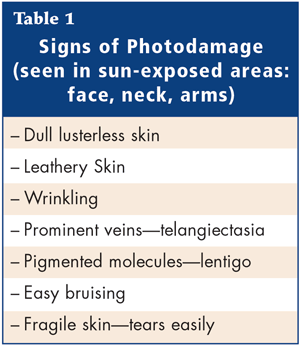John E. Adam MD, FRCPC, Professor of Medicine (Dermatology), University of Ottawa, Ottawa, ON.
The annual number of new cases of skin cancers reported in Canada is estimated to be about 40,000. With the aging of the baby boomer generation, this figure is anticipated to increase because of the ease of travel to the south in winter and increased exposure to the sun during outdoor activities. Dermatoheliosis or photodamage is most prevalent in people over 40 years of age who have had excessive sun exposure over their lifetime (Table 1). Epidemiological studies have identified sunlight exposure as the major risk factor for skin cancer.

There are three major types of skin cancer. The most common non-melanocytic skin cancers are Basal Cell Carcinoma and Squamous Cell Carcinoma. The less frequently occurring melanocytic skin cancer is Malignant Melanoma.
Basal cell carcinoma
Basal Cell Carcinoma (BCC) is the most common form of skin cancer but also the least likely to metastasize. It can be very destructive locally if not diagnosed and treated early.
Clinically it presents in several forms on sun-exposed areas (Table 2). The classic and most common presentation is the nodulo-cystic variety--a shiny elevated dome shaped nodule with a raised border often with telangiectatic blood vessels on the surface. The tumour is described as shiny or of a "mother-of-pearl colour.

